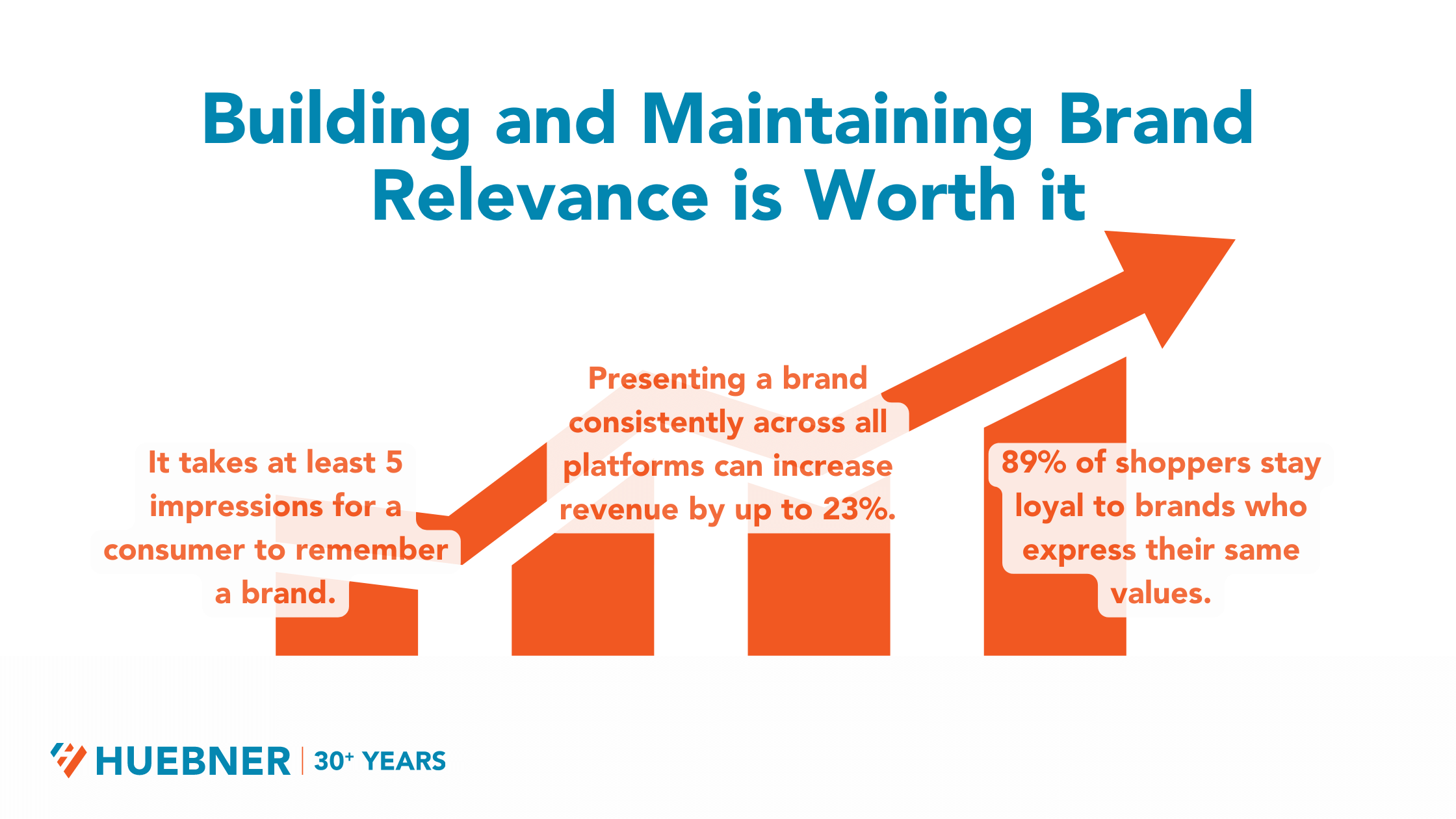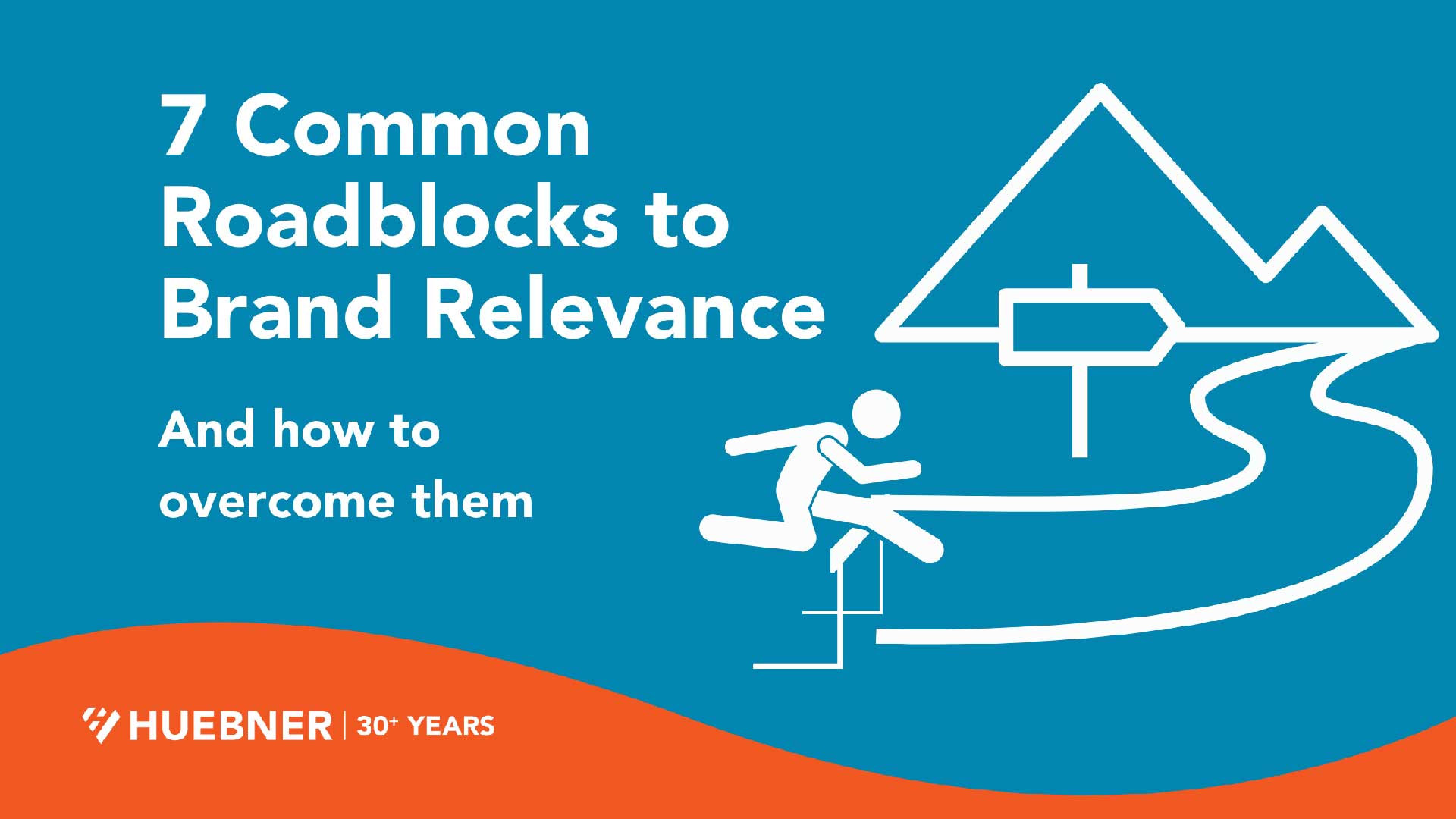We spend a lot of time and brainpower working with brands to identify the path to greater relevance with their customers. The path to brand relevance can be defined, mapped, and achieved for every brand that’s willing to put in the work. It is important to be aware of roadblocks that brands of all shapes and sizes face in becoming (and staying) relevant.
In our 33 years of experience, we’ve found there are 7 common roadblocks to brand relevance.
7 Common Roadblocks to Brand Relevance
- We’ve Always Done it this Way Mentality
- Shiny Object Syndrome
- Neglecting Internal Work
- Inconsistent Efforts
- Unclear Voice
- Undefined Audience
- Ineffective Website
We’ve Always Done it this Way Mentality
“We’ve always done it this way.” These are dangerous words in the business world, but we hear them all too often when reviewing past marketing performance. Relying on what’s worked in the past may seem like an obvious place to start, but if it’s the only direction given to the marketing team, it can halt business growth, stall product innovation, and send your marketing efforts into an aimless spiral.
The ability to evaluate past efforts and pivot to data-based marketing needs to be a key capability within your organization. The world, your audience, and the market is always changing. The only way to keep up is to continually review and iterate (on repeat).
If you’re not sure how to get an honest perspective on your current efforts and try something new, lean into research. A brand positioning study can provide priceless details on how customers view your brand, how current messaging is interpreted, and how best to pivot to address your true audience.
Shiny Object Syndrome
Discipline. It’s hard to come by. It’s easy to be distracted by “shiny objects”— ideas that show promise but aren’t tied to current business objectives.
How can you stay focused? Create clear goals and tie them to metrics you can measure. Next, rely on that data to make informed decisions about who, how, and where to engage. Stick with your plan long enough to measure results. Take your “shiny objects,” add them to your backlog, and keep high-level business objectives in mind to vet your new ideas before you change priorities.
Brand relevancy depends upon the ability to reach your intended audience(s) effectively. That may take a few rounds of testing and editing, but once you’ve honed in on your approach, you should be able to rely on those methods . . . as long as the metrics tell you they are still working.
Neglecting Internal Work
Busy marketing teams often fall into the trap of prioritizing external efforts and putting less visible projects on the back burner. Sure, new product rollouts and promotional campaigns drive traffic and revenue, but so does consistent delivery of copy and imagery that communicates your brand’s mission, vision, and ethos.
Regular review of your messaging and voice may feel like a chore, but when you make it a priority, you’ll see a direct increase in audience/market/consumer reach, engagement, and conversion. And, you guessed it, that adds up to a more relevant brand.
Inconsistent Efforts
Inconsistent marketing efforts are often the result of another common roadblock: competing priorities. It can be difficult to show up regularly (and with the same quality and message) in all marketing channels if you’re being pulled in too many directions. Yet consistency is key to presenting a reliable, dependable brand, and to connecting with your audience in a meaningful way. It also ensures messaging is seen, and your brand is remembered.
If you find it difficult to be consistent, narrrow your focus. You don’t have to be on every available social media platform if your audience isn’t there. Show up regularly where it counts, and keep your brand relevant and top of mind by creating a consistent engagement schedule. Whether you email, direct mail, text message, post on social media, or do all of the above, keep your schedule consistent and watch your audience engage and grow.
Unclear Voice
The average person receives over 100 emails and sees close to 10,000 ads every day.
You can cut through that noise and stand out from your competitors by focusing in on your brand’s voice.
Are you speaking to your customers with a clear and consistent voice? Does your brand look, feel, and sound the same across marketing channels? Clear and consistent communication is key to building a meaningful connection and remaining relevant to your target audience.
In order to speak in a clear voice, you have to know what it is. Start with identifying your brand archetype and filter your messaging through that lens. Questions to ask yourself and your team when building your voice are:
- What are your goals?
- What are your values and mission?
- What kind of people do well in your organization?
- How do you talk about your customers?
- What does your product or service enable them to do?
From there, you can define an identity a voice that is easy to recognize, that your marketing team can use with discipline, and that customers will connect with and trust.
Undefined Audience
Even the most refined and polished brand voice will fall on deaf ears if you don’t have clarity about your target audience. If you don’t know who will benefit most from your product or service, then you can’t expect to be relevant to them.
Market research and competitor analysis will help you define your audience and their personas, and understand how best to connect with them. Content marketing, advertising, and social media programs should all be built on this foundation: a concrete understanding of your target audiences.
Ineffective Website
When was the last time you reviewed your website? Experts recommend your website should be re-designed every two to three years, for two important reasons:
First, is the speed of technology. Three years is a lifetime in the digital world. An untouched site may suffer from performance issues, lose credibility with search engines, and give visitors an innacurate perception of your brand. New website features and design modifications should be evaluated for effectiveness and efficiency when it comes to audience retention and conversion. If you fail to keep up with the technology, you will ultimately fail to engage your audience, as the site can become slow, hard to navigate, and feel tired and outdated.
Next, is consumer preference. As technology changes, so does consumer behavior. Shifting color schemes, navigation paths, and content styles (long form vs. short form) etc, can provide just the refresh needed to drive new user conversion and re-engage existing consumers.
If it has been a couple of years since your last refresh or rebuild, it’s time to take a look at your current site’s analytics and existing industry trends. If you think there is room for improvement, then now is a good time to work with your creative agency or team to develop new designs and user flows that will resonate with your intended audience.
Overcoming Roadblocks to Brand Relevance Takes Work. But it’s Worth it.
Becoming and staying relevant as a brand is hard work. It requires strategic thought and disciplined execution. It demands dedication. And it is all worth it.
Building and maintaining a brand that is relevant to your audience is key to the growth and success of your business. Brands that commit to overcoming these obstacles and staying relevant will be rewarded with loyal customers and a strong and lasting brand for years to come.

*Brand relevancy statistics, sourced:
